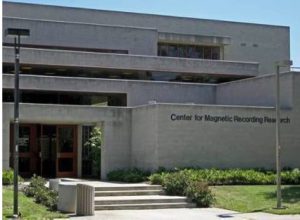History (1978): Consortia Pursue Storage R&D Projects
Academic, government and industry research consortia established
This is a Press Release edited by StorageNewsletter.com on May 3, 2018 at 2:05 pmThis article comes from the Computer History Museum.
1978: Consortia pursue storage R&D projects
Academic, government & industry research consortia established

(Center for Magnetic Recording Research, U.C. San Diego)
In 1978 the Japanese Ministry of Information and Technology (MITI) sponsored a cooperative R&D program aimed at very large scale integrated circuits (VLSI) to boost the national electronics industry.
A follow-on commercialization phase involving five leading electronics companies leapfrogged Japan to a leadership position in 64K DRAM and larger semiconductor memory chips in the 1980s.
Contemporaneously, MITI also sponsored a cooperative R&D program to advance magnetic disk drive technology. A partnership between NTT, NEC, Hitachi and Fujitsu developed the industry-leading disk drive prototypes PATTY and GEMMY. These breakthroughs threatened the competitiveness of key U.S. companies as well as national interests in both fields, and catalyzed the establishment of university-government-industry research consortia in the U.S.
The Semiconductor Industry Association (SIA) sponsored the 1982 creation of the Semiconductor Research Corporation (SRC) chaired by IBM vice-president Erich Bloch. SRC has supported university semiconductor research for over 30 years and developed initiatives such as the International Technology Roadmap for Semiconductors.
In 1987 fourteen U.S.-based semiconductor companies formed SEMATECH in Austin, TX, to employ Department of Defense matching funds to address problems in equipment and manufacturing.
After U.S. industry regained the lead in the 1990s government funding ceased and in 2003 SEMATECH relocated its headquarters to the State University of New York, Albany.
In 1982, IBM led the initiative to organize a consortium of disk drive companies to fund data storage research centers in academia. The first two, the Center for Magnetic Recording Research, U.C. San Diego, CA, led by Professor John Mallinson, and what evolved to become the Data Storage Systems Center, Carnegie Mellon University (CMU), Pittsburgh, PA, led by Professor Mark Kryder, were founded in 1983-84. Seven additional centers were established afterwards, most recently one in Singapore.
The U.S. centers were in part supported by the National Science Foundation (NSF), and the Departments of Commerce and Defense. The National Storage Industry Consortium (NSIC) was incorporated in 1991 to coordinate research programs on computer storage. It initially focused on technology objectives defined by U.S. companies and later, as INSIC, expanded to include non-U.S. companies.
These consortia contributed to the advancement of key storage technologies, including giant magneto-resistive heads and perpendicular magnetic recording.













 Subscribe to our free daily newsletter
Subscribe to our free daily newsletter

